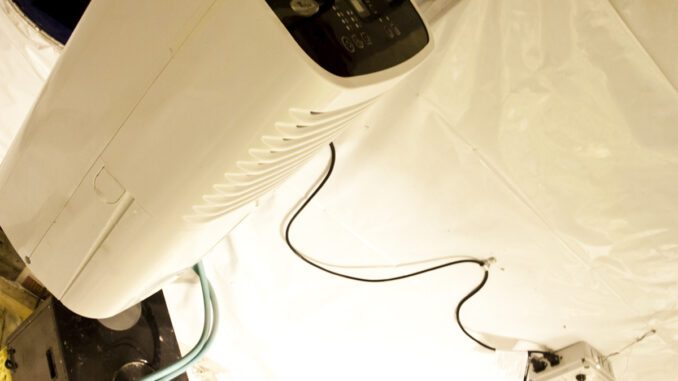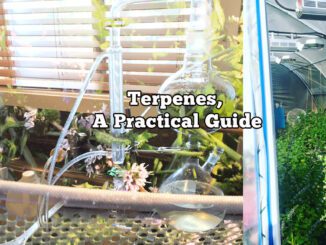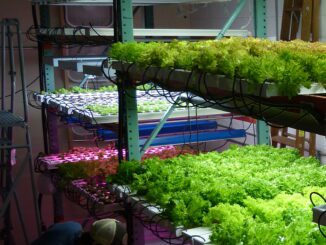
Grow Tips for Relative Humidity
[quote]Once plants develop a thicker canopy of leaves (essentially creating their own micro-climate) finding the right RH level for your strain, climate and growth phase becomes a useful tool in regulating plant growth patterns and growth rates.[/quote]
Finding the right bandwidth for Relative Humidity (RH) levels in your indoor or greenhouse garden can have a significant impact on what you harvest from your garden, and the degree of difficulty you may experience arriving there. Check these Grow Tips for Relative Humidity.
Of course if you grow indoors hydroponically, you will have heard about the importance of RH-however, once you learn and even master how it actually works on your plants and how they will respond to different ranges is when you may realize how much you may have underestimated this unseen force that is at work in your grow,
And it is in fact a force that is at work. The water vapor that surrounds the leaves of your plant will in large part, play a role in how fast your plant can freely transpire moisture into the air, after it has been taken up the roots (transporting water and nutrients) and exists through the tiny openings in the leaves called stomata. Essentially, the higher the concentration of water vapor (ie, higher humidity level) that surrounds the micro-climate around the stomata, the greater the degree of external pressure that is put against the water trying the leave the plant, pardon the pun.
Tip: You can offset your water-consumption footprint by supplementing your R.O. filtered garden water with “living” water that you capture as condensate. After practicing, you will better gauge when it is time to water again 😉
In short, most gardeners have realized: the drier the air, the quicker the plant can lose moisturen with higher RHlevels contributing to lowered water loss by plants into the air.
That in itself is virtually useless information to you as a grower-what you need to understand is when and how far to push or loosen that external pressure on the plant for healthy growth as varies with climate and growth phase.
During propagation, we don’t want plants to lose water too quickly; they don’t have the root system to support higher loss levels and plants get stressed or worse. During germination and rooting cutting, levels of around 85-90% are common. Once roots are showing, this level is gradually lowered.
Typically, during transplant and early vegetative growth, most plant strains respond well to RH levels in the neighbourhood of 65%, here we are encouraging more water and nutrient uptake but are still being careful not too push the plant too much before it’s ready.
CAUTION: Humidity levels of above 50% indoors can contribute to condensation where warmer air temperatures may be contacted cool temperatures, for example cold air intake ducting-be careful no drips are created that cause water pooling or damage. Typically this isn’t a problem; cold water pipes or cold air ducting may be insulated to prevent this.
Once plants develop a thicker canopy of leaves (essentially creating their own micro-climate) finding the right RH level for your strain, climate and growth phase becomes a useful tool in regulating plant growth patterns and growth rates.
One of the reasons plants will stretch more is if the humidity levels rise higher than 60% in the dark phase or when the lights are on in early flower. Plants sense there is more water vapor in the air, and then create more distance between sets of leaves in order to compensate for it. Stretching is not desirable indoors, as artificial light intensity drops quickly with distance it travels.
Later on in flowering, if humidity levels are past 65% when flower have formed, typically they will be looser and more “airy” versus flowers that develop more in the 55% RH humidity bandwidth. (+/-5%). Higher humidity levels in late bloom contribute to rots and in early bloom may encourage flower abortion in tomato, for example, and weaken pollination.
However, drier isn’t always better; especially earlier on. If your plants don’t have at least 45% RH they typically suffer. While you may think this is a novel way to stimulate faster growth, typically this creates more stress than anything. Leaf margins that curl upwards a a sign the air is too dry. It’s also a sign that your plants are running short on Potassium (K), because they will need more of it to regulate the stomata in drier air. Powdery mildew is more likely to happen in drier air than with a higher RH, especially if plants are soft due to higher Nitrogen levels.
Depending on your set-up and season whether you need to ADD or REMOVE humidity is what you will first need to determine.
Adding humidity is typically much easier and affordable. A humidifier with a humidifying (on DROP) stat is all you need. This is pure gold for CEA growers in the earlier stages, where the air tends to be driers from big air-conditioners.
Removing water vapor can be more costly and intensive. Typically a vent fan, or better yet a de-humidifier connected to a Dehumidistat (on RISE). Note that de-humidifiers tend to add heat to the grow air, but luckily they are usually only active in the dark cycle because either the exhaust fan or air conditioner will remove enough water vapor from the air while the lights are on.
As a final note, when humidity levels are higher, you can feed a little stronger, when drier back-off. If you anticipate that the humidity will drop and you have been fertilizing your plants more strongly, back off on the strength for a couple of successive applications.



